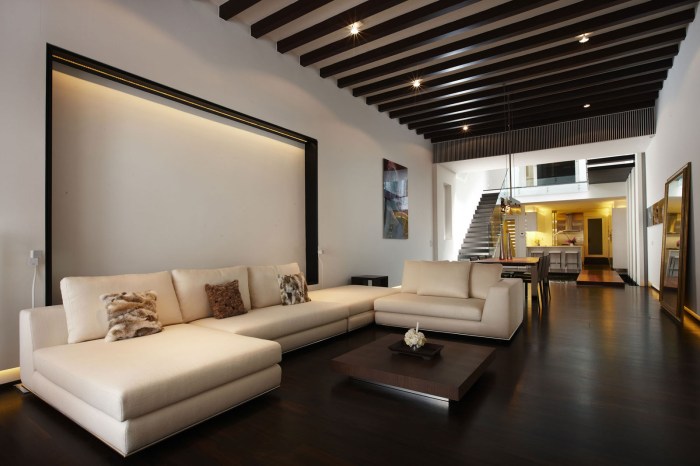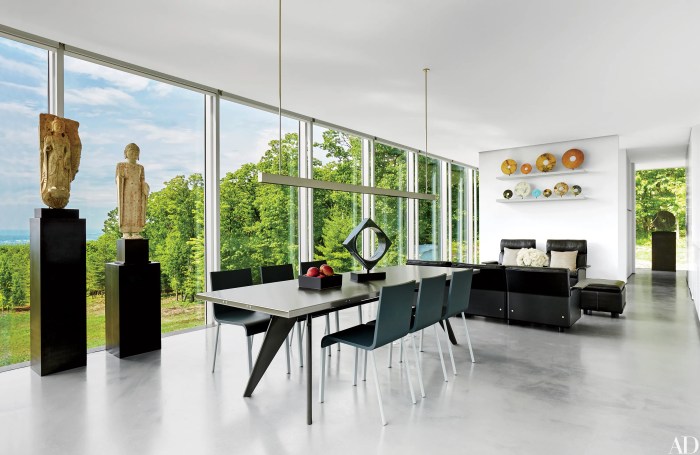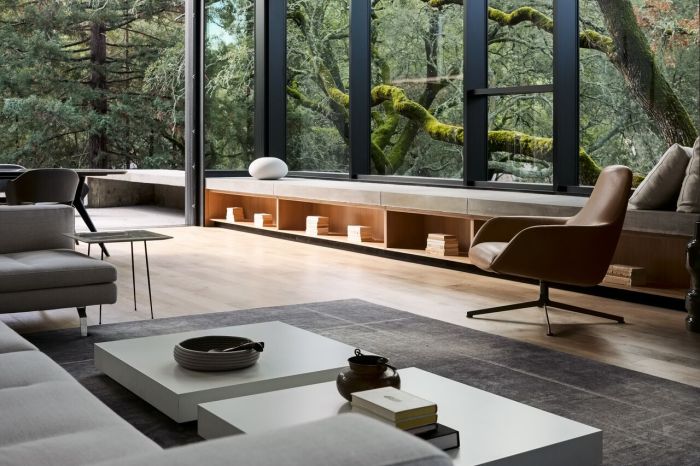Exploring the World of Interior Architecture

Step into the realm of interior architecture where creativity meets functionality and design. From historical influences to sustainable practices, this field offers a fascinating journey through the evolution of interior spaces.
Delve deeper into the key elements, technological integrations, and the delicate balance between aesthetics and functionality that shape the world of interior architecture.
Definition of Interior Architecture
Interior architecture involves the design of indoor spaces, focusing on the functionality, aesthetic appeal, and overall experience within a built environment. It encompasses the planning, layout, and organization of interior spaces to enhance the quality of life for the occupants.Interior architecture differs from interior design in that it goes beyond just the decoration of a space.
While interior design focuses on the selection of furniture, color schemes, and decor elements, interior architecture involves a deeper level of planning and consideration of the structural elements within a space.
How Interior Architecture Influences Spatial Design
Interior architecture influences spatial design in various ways, such as:
- Structural Layout: Interior architects design the layout of a space to optimize functionality and flow, taking into consideration factors like circulation, sightlines, and zoning.
- Integration of Technology: Interior architecture integrates technology seamlessly within a space, considering factors like wiring, lighting, and smart home systems.
- Material Selection: Interior architects carefully select materials based on their durability, sustainability, and aesthetic appeal, influencing the overall look and feel of a space.
- Spatial Planning: Interior architecture focuses on creating spaces that are not only visually appealing but also efficient and practical, ensuring that every area serves its intended purpose.
Elements of Interior Architecture

Interior architecture is defined by several key elements that work together to create functional and aesthetically pleasing spaces. These elements include spatial layout, materials, lighting design, color schemes, furniture selection, and decorative elements.
Role of Materials in Interior Architecture
Materials play a crucial role in interior architecture as they determine the quality, durability, and overall atmosphere of a space. The choice of materials can impact the aesthetics, functionality, and sustainability of a design. For example, using natural materials like wood and stone can create a warm and inviting ambiance, while modern materials like glass and metal can give a space a sleek and contemporary feel.
It is important for interior architects to carefully consider the properties and characteristics of different materials to achieve the desired design outcome.
Lighting Design in Interior Architecture
Lighting design is a fundamental element in interior architecture that can dramatically transform the look and feel of a space. Proper lighting can enhance the mood, highlight architectural features, and improve the functionality of a room. There are different types of lighting, including ambient, task, and accent lighting, which should be carefully integrated to create a balanced and harmonious environment.
Natural light is also an important consideration in interior architecture, as it can affect the overall atmosphere and energy efficiency of a space. Interior architects must strategically plan the placement of light fixtures, as well as utilize natural light sources, to maximize the impact of lighting design on the overall design scheme.
Historical Evolution of Interior Architecture
Interior architecture has evolved over centuries, reflecting the cultural, social, and technological advancements of different eras. The history of interior architecture is a fascinating journey that showcases how various architectural styles have influenced the design of interior spaces.
Ancient Times
In ancient civilizations like Egypt and Mesopotamia, interior architecture was closely tied to religious beliefs and rituals. Interiors were adorned with intricate carvings, colorful murals, and symbolic motifs, creating a sense of grandeur and spirituality.
Classical Period
During the Classical period in Greece and Rome, interior architecture focused on harmony, proportion, and symmetry. The use of columns, arches, and frescoes characterized the interiors of temples, palaces, and public buildings, reflecting the ideals of beauty and order.
Medieval and Renaissance Era
In the Medieval and Renaissance periods, interior architecture saw a revival of classical elements combined with intricate ornamentation. Gothic cathedrals featured lofty vaulted ceilings and stained glass windows, while Renaissance palaces showcased rich tapestries, frescoes, and ornate furniture.
Baroque and Rococo Styles
The Baroque and Rococo styles of the 17th and 18th centuries emphasized opulence, drama, and elaborate decoration. Interiors were characterized by ornate stucco work, gilded accents, and luxurious fabrics, creating a sense of decadence and grandeur.
Modern and Contemporary Design
In the 20th and 21st centuries, interior architecture embraced modernist principles of simplicity, functionality, and minimalism. Influential designers like Le Corbusier, Ludwig Mies van der Rohe, and Frank Lloyd Wright revolutionized interior design with innovative materials, open floor plans, and sleek aesthetics.Iconic examples of interior architecture from different time periods include the Parthenon in Ancient Greece, the Palace of Versailles in France, the Sistine Chapel in Vatican City, the Palace of Westminster in England, and the Guggenheim Museum in New York.
Functionality and Aesthetics in Interior Architecture

Interior architecture strives to find the perfect balance between functionality and aesthetics in designing interior spaces. It is essential to create spaces that not only look visually appealing but also serve their intended purpose efficiently. Let's delve into how these two aspects are intertwined in interior architectural design.
Innovative Ways to Combine Functionality and Aesthetics
In interior architecture, innovative solutions are constantly being developed to seamlessly blend functionality with aesthetics. Some examples include:
- Multi-functional furniture pieces that serve dual purposes while adding a stylish element to the space.
- Smart technology integration for lighting, temperature control, and security that enhances both the functionality and visual appeal of the space.
- Use of sustainable materials and design techniques that not only contribute to the aesthetic value but also promote a healthier environment.
User Experience in Interior Architectural Design
User experience is a crucial factor considered in interior architectural design to ensure that the space is not only visually pleasing but also practical and comfortable for its occupants. Design elements such as ergonomic furniture, efficient layout planning, proper lighting, and acoustics play a significant role in enhancing the user experience within a space.
Sustainable Practices in Interior Architecture
Sustainability in interior architecture plays a crucial role in creating spaces that are environmentally friendly, socially responsible, and economically viable.
Importance of Sustainability in Interior Architecture
Sustainability in interior architecture focuses on reducing the environmental impact of design decisions, promoting the health and well-being of occupants, and using resources efficiently.
Sustainable Materials and Techniques in Interior Architectural Design
- Using recycled and upcycled materials to reduce waste and conserve resources.
- Incorporating energy-efficient lighting systems and appliances to decrease energy consumption.
- Utilizing low-VOC (volatile organic compound) paints and finishes to improve indoor air quality.
- Implementing passive design strategies such as natural ventilation and daylighting to reduce reliance on mechanical systems.
- Integrating green walls and living plants to enhance indoor air quality and biophilic design principles.
Examples of Eco-Friendly Interior Architecture Projects
One prominent example of sustainable interior architecture is the Bullitt Center in Seattle, known as the "greenest commercial building in the world." This project incorporates features such as rainwater harvesting, solar panels, composting toilets, and natural ventilation to achieve net-zero energy and water consumption.
Technology Integration in Interior Architecture

Technology plays a crucial role in shaping modern interior architecture, revolutionizing the way spaces are designed and experienced. From smart home systems to cutting-edge advancements, the integration of technology has transformed the field in numerous ways.
Smart Home Systems Impact
Smart home systems have significantly impacted interior architectural design by enhancing convenience, efficiency, and sustainability. These systems allow for remote control of lighting, heating, security, and other elements, creating a more comfortable and personalized living environment. They also contribute to energy savings and environmental sustainability, aligning with the growing trend towards green design practices.
Cutting-Edge Technological Advancements
Innovations such as augmented reality (AR) and virtual reality (VR) are increasingly being utilized in interior architecture to provide clients with immersive experiences and realistic visualizations of design concepts. 3D printing technology is also revolutionizing the way furniture and fixtures are created, offering endless possibilities for customization and unique design solutions.
Furthermore, the integration of IoT (Internet of Things) devices and sensors in interior spaces enables real-time data collection and analysis, leading to more efficient and responsive designs.
Ultimate Conclusion
As we conclude our exploration of interior architecture, we are reminded of the intricate blend of artistry and practicality that defines this field. From iconic examples to cutting-edge innovations, the impact of interior architecture on our surroundings is undeniable and ever-evolving.
Top FAQs
What is the difference between interior design and interior architecture?
Interior design focuses on aesthetics and functionality within interior spaces, while interior architecture involves the structural layout and design of those spaces.
How does lighting design contribute to interior architecture?
Lighting design plays a crucial role in highlighting architectural features, creating ambiance, and enhancing the overall look and feel of a space in interior architecture.
Why is sustainability important in interior architecture?
Sustainability in interior architecture promotes environmentally friendly practices, reduces carbon footprint, and ensures long-term viability of interior spaces.

